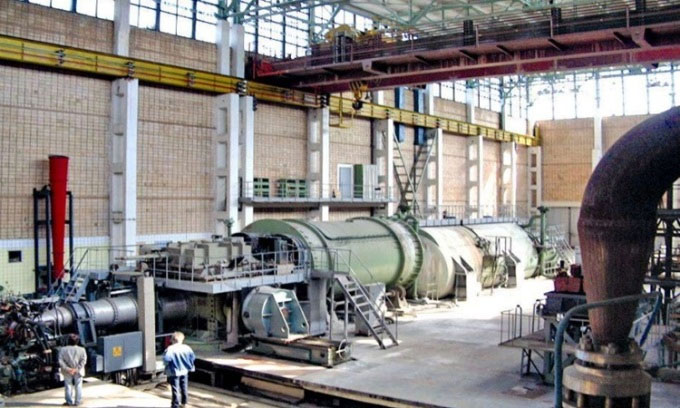5 strongest wind tunnels in the world
A wind tunnel is a machine that simulates the flow of air through objects, helping to test the aerodynamics of countless aircraft and missiles.
The system consists of a long narrow pipe where air is introduced using various methods such as powerful fans. Inside the tube is the model or object to be tested.
The incoming air flow will be controlled to study its effect on the object under different conditions such as changing wind speeds.
Wind tunnels were first developed in the late 19th century, and are now widely used in many industries. Interesting Engineering has released a list of the most powerful wind tunnels today.
1. JF-22

The JF-22 built at the Institute of Mechanical Engineering of the Chinese Academy of Sciences (IMCAS) north of Beijing is the world's most powerful hypersonic wind tunnel. The JF-22 has a diameter of 4 m, can reach speeds of up to Mach 30 (37,044 km/h or 10.3 km/s).
The JF-22 uses timed explosions to produce shock waves that reflect each other and converge at a point inside the pipe to create such a high-speed gas flow. JF-22 can provide a capacity of 15 gigawatts (GW), equal to 70% of the capacity of the Three Gorges Dam, the world's largest hydroelectric dam.
2. JF-12
JF-12 is an open-circuit wind tunnel that uses shock waves to create flight conditions from Mach 5 (6,174 km/h) to Mach 9 (11,174 km/h), at altitudes from 25,000 m to 50,000 m.
The JF-12 was built by the Institute of Mechanical Engineering of IMCAS in 2008 - 2012, playing an important role in the development of the hypersonic glider vehicle (HGV) of China's DF-ZF.
3. T-117 TsAGI supersonic wind tunnel

T-117 TsAGI is a large supersonic wind tunnel built in the 1970s at the Central Institute of Hydrodynamics in Moscow, Russia.
The system operates according to the blowdown rule, high pressure gas is quickly released into the remaining area in the wind tunnel to create a gas flow. The gas stream is heated by two separate electric furnaces that can be removed depending on the experiment.
The T-117 TsAGI can generate test speeds from Mach 5 (6,174 km/h) to Mach 10 (12,348 km/h) and simulate the high temperatures that hypersonic vehicles encounter in flight.
The hypersonic flight mode of the Federation spacecraft was tested by the T-117 TsAGI in 2018. This is a project of the Russian space agency Roscosmos to replace the Soyuz spacecraft in various missions in the low orbit of Earth and Moon.
4. Hypersonic Tunnel Facility (HTF)
The hypersonic tunnel facility (HTF) specializes in testing large-scale hypersonic air-suction propulsion systems at speeds from Mach 5 (6,174 km/h) to Mach 7 (8,644 km/h), simulating actual altitudes (36,500 m). The facility is located at NASA's Neil Armstrong Test Facility, within the Glenn Research Center in Sandusky, Ohio.
The testing area in the HTF is adjustable from 3.05 m to 4.27 m. There, a graphite-core thermal charge furnace can produce pollution-free artificial air in real proportions by heating nitrogen gas, then mixing it with oxygen and nitrogen at room temperature. According to the specific requirements for the test, the temperature of the artificial air is controlled. Depending on operating conditions, HTF can operate every 5 minutes.
5. Unitary Plan Wind Tunnel (UPWT)
Unitary Plan (UPWT) is located at NASA's Ames Research Center in Moffet Field, California. The tunnel, completed in 1955, is responsible for testing both conventional aircraft (commercial and military) and spacecraft.
UPWT includes 3 closed circuit wind tunnels: 3.4 x 3.4 m subsonic wind tunnel (TWT), 2.7 x 2.1 m supersonic wind tunnel and 2.4 x supersonic wind tunnel 2.1 m. These wind tunnels operate thanks to 4 electromagnetic motors with wound rotors with a capacity of 65,000 horsepower, operating at 7,200 volts.
The final wind tunnel can reach speeds of Mach 3.5 (4,321 m).
UPWT played a key role in the development of Boeing's fleet of aircraft as well as the F-111 fighter and B-1 Lancer bomber.
You should read it
- The ancient 3,300-year-old tunnel was discovered in Turkey
- What will happen if the wind stops blowing on Earth?
- Prestigious address selling wind-cutting fans, wind-breakers in Hanoi and Ho Chi Minh City
- How to Fit Wind Deflectors
- How much wind turbines are needed to meet the power needs of our planet Earth?
- Secure web tunnel setting
 Steve Jobs' most controversial design
Steve Jobs' most controversial design 5 eternal fires in the world
5 eternal fires in the world Discovering another human 'weapons factory' in a quarry in Israel
Discovering another human 'weapons factory' in a quarry in Israel Harvard University removed the human skin used as a book cover
Harvard University removed the human skin used as a book cover If there is an apocalypse due to climate change, this Earth black box will store all the data
If there is an apocalypse due to climate change, this Earth black box will store all the data Prehistoric women were more suited to hunting than men?
Prehistoric women were more suited to hunting than men?